This recipe shows how you will connect JasperReports to your database. I am using an open source database named PostgreSQL to hold the sample data of almost all recipes of this cookbook. That's why in this recipe you will connect iReport with your PostgreSQL installation. This recipe also shows that you can connect iReport to any of the popular databases in a similar manner.
You will need PostgreSQL to follow this recipe. Refer to the installPostgreSQL.txt file included in the source code download for this chapter, which shows how you will install and run PostgreSQL. Note that your installation of PostgreSQL should be up and running before you proceed.
The source code for this chapter also includes a file named CreateDbIntoPGS.txt, which will help you to create a database named jasperdb5.
The following simple steps will show you how to connect iReport to a database:
- Run iReport; it will open with a Welcome Window, as shown in the following screenshot:
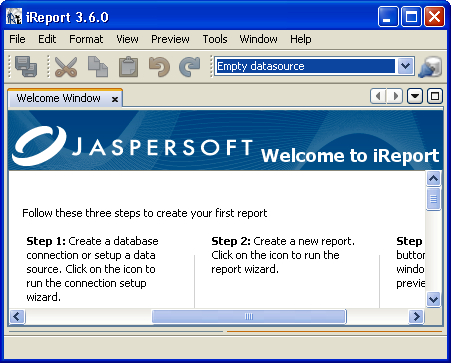
- If you have not made any database connection so far in your iReport installation, you will see an Empty datasource shown selected in a drop-down list just below the main menu. Click on the Report Datasources icon shown encircled to the right of the drop-down list, as shown in the following screenshot:

- A new window named Connections / Datasources will open, as shown in the following screenshot. This window lists an Empty datasource as well as the datasources you have made so far.
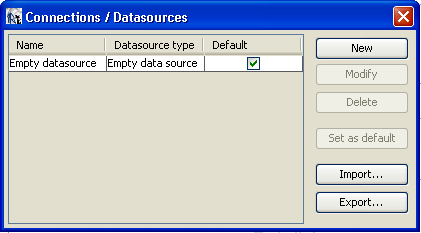
- Click the New button shown at the top right of the Connections / Datasources window. This will open a new Datasource selection window, as shown in the following screenshot:
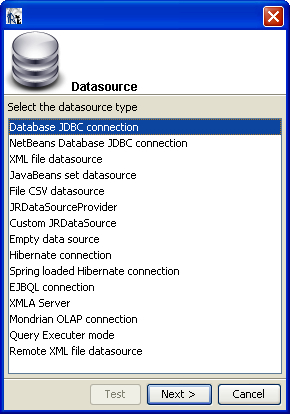
- You will see Database JDBC connection is selected by default. Click the Next button at the bottom of the Datasource window.
- A new window named Database JDBC connection will open, as shown in the following screenshot:
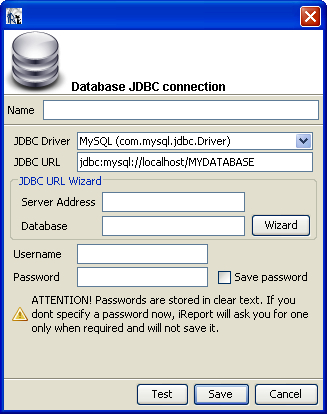
- Enter PG as the name for your new database connection in the input box beside the Name field.
- Click on the JDBC Driver drop-down list; it will drop-down to show a list of available JDBC drivers. As you are connecting to the PostgreSQL database, select the Postgre SQL (org.postgresql.Driver) option from the drop-down list, as shown in the following screenshot:
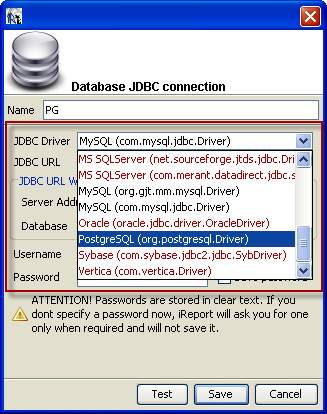
- Enter localhost as the name of the server hosting your database in the input box beside the Server Address field, as shown in the following screenshot:

- Enter jasperdb5 as the name of the database instance created in the Getting ready section in the Database field, as shown in the following screenshot:

Note
The name of the database instance will be different depending upon which database instance you are using. For this recipe you are using a database named jasperdb5 (which you created earlier in the Getting ready section). But when you are executing some other recipe, you will enter the name of the database instance that contains sample data for that particular recipe.
- Click the Wizard button available to the right of the Database text box. This will update the JDBC URL field, as shown in the following screenshot:

- Provide postgres as the value of the Username and Password fields, as shown in the following screenshot:

- Check the Save password checkbox beside the Password field shown in step 12 to save your database password permanently for reports generated using iReport.
- Click the Test button to test the new database connection. In the case of a successful connection, you will see a Connection test successful message in a dialog window. Dismiss the message by clicking the OK button.
- Click the Save button to save the newly created connection. You will see that the Connections / Datasources window will open showing your new connection set as the default connection in the connections list, as shown in the following screenshot:

- Now you are all set to generate a report from the data contained in your PostgreSQL installation. Whenever you are opening or viewing a report based on data contained in PostgreSQL, just make sure that PG is selected in the datasources drop-down list, as shown in the following screenshot:

You have learned how to connect iReport to PostgreSQL. If you have some other database, you just need to select the appropriate JDBC driver from the JDBC Driver drop-down list in step 8 of the recipe.
iReport comes bundled with drivers for the following open source databases:
- MySQL
- PostgreSQL
- HSQLDB
If you are not using an open source database, you will need to separately download and install the relevant JDBC drivers.
